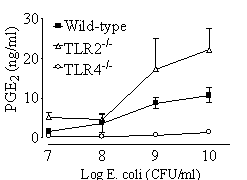| pA2 online © Copyright 2004 The British Pharmacological Society |
034P
GKT, University of London Winter Meeting December 2003 |
|
Toll like receptor (TLR) 4, but not TLR2 receptors are essential for the induction of COX-2 activity in vascular smooth muscle cells exposed to Gram negative bacteria
|
|
Leukocytes are stimulated by bacteria to kill and remove the invading pathogen. Vascular tissues may also activated by bacteria and express vasoactive/inflammatory genes, such as COX-2 (Jourdan et al., 1999). In macrophages, bacterial LPS is recognised, or "sensed" by the TLR4 pathway (Lee et al., 1992). Most recently, evidence suggests that TLR2 may also be involved in the recognition of 'unpurified' LPS (Tapping et al., 2000). However, the role of TLR4 or TLR2 in sensing Gram-negative bacteria by vascular smooth muscle cells is unknown. Thus, we have investigated the respective roles of TLR2 and TLR4 in the induction of COX activity in vascular smooth muscle cells stimulated with whole E. Coli bacteria or LPS.
Mouse aortic vascular
smooth muscle cells were cultured from control wild type (C57/BL6), TLR4-/-
or TLR2-/- mice, as we have described
previously (Jiménez et al., 2003). After 3-5 passages, cells were
grown to confluence in 96-well plates with serum being withdrawn for 24
h prior to experimentation. All treatments were made in DMEM containing
10% FCS and incubation maintained for 48h. COX activity was determinated
as the accumulation of prostaglandin E2
(PGE2) by RIA (Mitchell et al., 1993).
Under control culture conditions vascular smooth muscle cells released
low levels of PGE2. However, vascular
smooth muscle cultured from control or TLR2-/-
mice released increased levels of PGE2
after incubation with either whole (heat killed) E.Coli (107
to 1010 CFU/ml) bacteria or LPS (10µg/ml).
By contrast cells cultured from TLR4-/-
mice released low or undetectable levels of PGE2
in response to E Coli or LPS treatment (Fig. 1). The combination of IL-1ß
plus TNF![]() (10ng/ml for
each) also induced PGE2 release, an effect that was demonstrable in cells
cultured from control (basal, 8.65±1.39ng/ml; plus IL1b/TNF
(10ng/ml for
each) also induced PGE2 release, an effect that was demonstrable in cells
cultured from control (basal, 8.65±1.39ng/ml; plus IL1b/TNF![]() ,
3807.68±1392.27% vs basal), TLR2-/-
(1.15±0.15ng/ml; IL1ß/TNF
,
3807.68±1392.27% vs basal), TLR2-/-
(1.15±0.15ng/ml; IL1ß/TNF![]() ,
3387.36±971.14% vs basal) or TLR4-/-
mice (0.30±0.08ng/ml; IL1ß/TNF
,
3387.36±971.14% vs basal) or TLR4-/-
mice (0.30±0.08ng/ml; IL1ß/TNF![]() ,
1097.83±187.56% vs basal), (n=4-6). The increase in COX activity
induced by either LPS or the combination of IL-1ß plus TNF
,
1097.83±187.56% vs basal), (n=4-6). The increase in COX activity
induced by either LPS or the combination of IL-1ß plus TNF![]() in
all cell types was blocked by the COX-2 selective inhibitor rofecoxib
(100nM).
in
all cell types was blocked by the COX-2 selective inhibitor rofecoxib
(100nM).

Fig. 1. Prostanoid production by vascular smooth muscle cells in response to heat killed E. Coli. Data is mean ±s.e.m. for n=3 determinations, similar data was obtained using cells cultured from a separate aorta.
COX-2 is induced in vascular smooth muscle by whole Gram-negative bacteria or LPS in a manner that is dependent upon TLR4 and independent of TLR2. These findings have important implications for our understanding of vascular smooth muscle sensing of bacterial infections.
Jiménez et
al., (2003), Brit. J. Pharmacol 140: 7P.
Jourdan et al., (1999) Am J Respir Cell Mol Biol 21:
105-110.
Lee et al., (1992) J Biol. Chem. 267: 25934-25938.
Mitchell et al., (1993) Proc. Natl. Acad. Sci.,. 90:
11693-11697.
Tapping et al., (2000) J. Immunol. 165: 618-622.
R.J. is a Spanish Government Fellow. This work was supported by the MRC, the Joint Research Board of St. Bartholomew's Hospital, and The William Harvey Research Foundation.